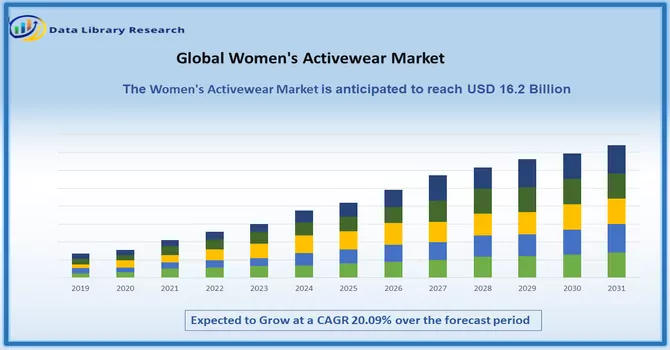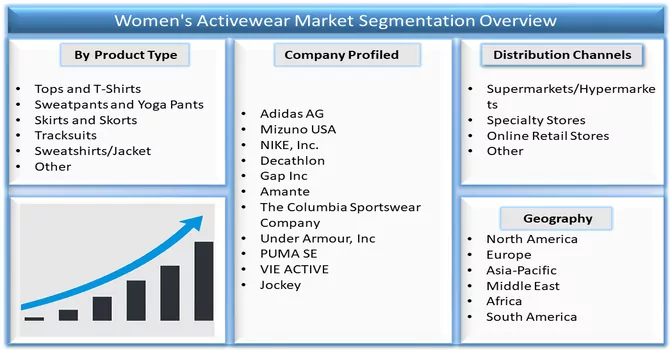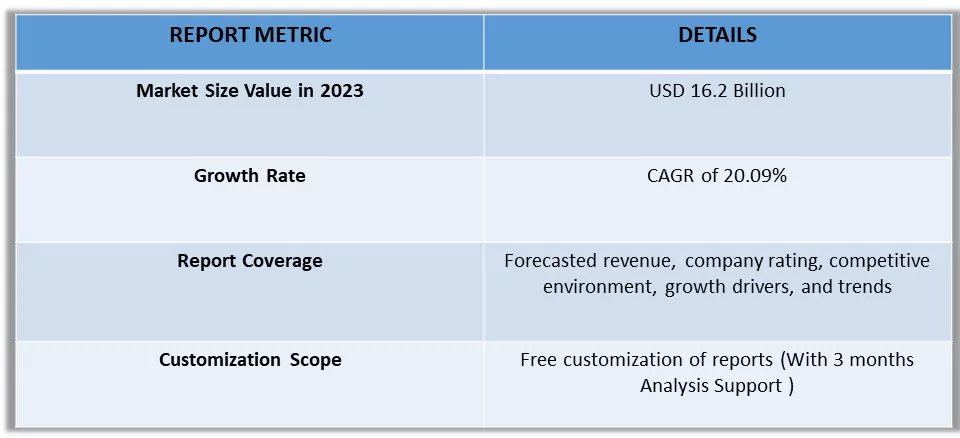Women's Activewear Market was USD 16.2 billion in 2023 and is predicted to rise at a CAGR of 20.09% during the projection period of 2024-2031.

Get Complete Analysis Of The Report- Download Free Sample PDF
The global women's activewear market has witnessed a dynamic evolution driven by shifting lifestyle preferences and a growing emphasis on health and fitness. In recent years, the demand for activewear designed specifically for women has surged, fueled by an increasing awareness of fitness, wellness, and athleisure trends.
The market encompasses a diverse range of apparel, including sports bras, leggings, tops, and athletic shoes, catering to the multifaceted needs of women engaging in various physical activities. The rise of athleisure, which seamlessly blends activewear with casual wear, has further propelled the market's growth. The integration of advanced materials and technologies, offering enhanced comfort, moisture-wicking properties, and style, has been a key driver. Additionally, the influence of social media, celebrity endorsements, and the cultural shift toward body positivity has significantly impacted consumer perceptions, contributing to the global surge in demand for women's activewear. As the focus on a healthy lifestyle continues to gain prominence, the women's activewear market is expected to witness sustained growth and innovation. A significant growth-driving factor for the global women's activewear market is the increasing emphasis on health and fitness worldwide. As health awareness becomes a central aspect of contemporary lifestyles, more women are actively engaging in various forms of physical activities, ranging from traditional sports to yoga and fitness workouts. This shift in consumer behavior has fueled a rising demand for specialized activewear that combines performance, comfort, and style. The growing popularity of athleisure, where activewear seamlessly transitions into casual wear, has further expanded the market. Additionally, advancements in fabric technologies, offering features like moisture-wicking, breathability, and stretchability, contribute to the appeal of activewear among women. The convergence of fashion trends with a wellness-oriented lifestyle is expected to continue propelling the global women's activewear market forward.
Market Segmentation: The Global Sports Wear For Women Market is segmented by Product Type (Tops and T-Shirts, Sweatpants and Yoga Pants, Skirts and Skorts, Tracksuits, Sweatshirts/Jacket, and Other Product Types), Distribution Channel (Supermarkets/Hypermarkets, Specialty Stores, Online Retail Stores, and Other Distribution Channels), and Geography (North America, Europe, Asia-Pacific, South America, and Middle-East and Africa).

For Detailed Market Segmentation - Download Free Sample PDF
In the global women's activewear market, several noteworthy trends are shaping consumer preferences and industry dynamics. Firstly, the rise of athleisure continues to influence the market significantly, blurring the lines between traditional athletic wear and everyday fashion. Women increasingly seek activewear pieces that seamlessly transition from the gym to casual settings, emphasizing both style and comfort. Sustainable and eco-friendly activewear options are gaining traction, reflecting a broader consumer trend toward ethical and environmentally conscious choices. The integration of smart technology, such as fitness trackers or embedded sensors, into activewear garments is another emerging trend, enhancing the overall fitness experience for consumers. As social media and influencer culture continue to thrive, collaborations between activewear brands and fitness influencers are becoming more prevalent, driving brand visibility and connecting with target audiences. These trends collectively underscore the evolving landscape of the global women's activewear market.
Market Drivers:
The increasing awareness and emphasis on a healthy and active lifestyle among women are significant drivers
The increasing awareness and emphasis on a healthy and active lifestyle among women serve as significant drivers for the global activewear market. In recent years, there has been a notable shift in consumer preferences towards healthier living, with more women recognizing the importance of regular physical activity. This heightened awareness has led to a surge in demand for activewear that seamlessly blends style and functionality, catering to the diverse needs of women engaged in various forms of exercise and wellness activities. As a result, activewear brands are innovating to provide comfortable, performance-oriented, and aesthetically pleasing apparel, capitalizing on the trend of women embracing active lifestyles as an integral part of their daily routines.
The rise of e-commerce and digital platforms is a major driver for the women's activewear market
The rise of e-commerce and digital platforms stands out as a major driver for the women's activewear market. With the increasing prevalence of online shopping and the convenience it offers, women now have greater access to a wide array of activewear options at their fingertips. E-commerce platforms enable consumers to explore, compare, and purchase activewear from the comfort of their homes, fostering a seamless and efficient shopping experience. The digital landscape has also facilitated direct-to-consumer models, empowering activewear brands to establish a more direct connection with their target audience. The convenience of online shopping, coupled with the extensive product choices and personalized recommendations provided by digital platforms, contributes significantly to the growth and accessibility of the women's activewear market.
Market Restraints:
Market restraints for the global women's activewear market include challenges related to sustainability and environmental concerns. As consumers increasingly prioritize eco-friendly and sustainable products, there is a growing demand for activewear made from environmentally conscious materials. This shift poses a restraint for traditional activewear manufacturers that may need to adapt their production processes and sourcing strategies to meet these evolving consumer expectations. Additionally, competition in the market is intensifying, leading to pricing pressures and the need for brands to differentiate themselves through unique designs, innovative features, and sustainable practices. Balancing these factors while maintaining affordability can be a challenge for businesses in the women's activewear sector. Navigating these constraints requires strategic approaches to sustainability, brand positioning, and operational efficiency to stay competitive in an evolving market landscape.
The global women's activewear market has experienced a notable impact from the COVID-19 pandemic. The lockdowns, social distancing measures, and lifestyle changes implemented to curb the spread of the virus led to shifts in consumer behavior. With gyms closed and outdoor activities restricted, there was a temporary decline in the demand for activewear. However, as people adapted to new fitness routines at home and embraced a more casual and comfortable style, there was a surge in the popularity of athleisure wear.E-commerce emerged as a crucial channel during the pandemic, allowing consumers to shop for activewear from the safety of their homes. This shift accelerated the digital transformation of the retail landscape, and brands that invested in robust online platforms and omnichannel experiences gained a competitive edge.Moreover, the pandemic underscored the importance of health and wellness, driving a long-term trend towards an active lifestyle. As restrictions eased, there was a resurgence in demand for women's activewear, fueled by a renewed focus on fitness, outdoor activities, and the broader acceptance of athleisure as a mainstream fashion choice.While the initial impact of the pandemic posed challenges, the industry's adaptability and alignment with changing consumer preferences have positioned it for recovery and future growth in the post-COVID era.
Segmental Analysis:
Sweatpants and Yoga Pants Segment is Expected to Witness Significant growth Over the Forecast Period
Sweatpants and yoga pants are key segments in the women's activewear market, offering comfort, flexibility, and style for various activities. Sweatpants, traditionally associated with casual wear, have evolved to include performance features like moisture-wicking fabrics and stretch materials, making them popular for workouts and athleisure wear. Yoga pants, designed with flexibility and comfort in mind, often feature high waistbands and stretchy fabrics that provide support during yoga practice and other low-impact activities. The women's activewear market has seen significant growth in recent years, driven by factors such as increased participation in fitness activities, a growing focus on health and wellness, and a rise in athleisure fashion trends. Major brands and retailers have expanded their activewear offerings to cater to this demand, offering a wide range of styles, colors, and sizes to appeal to a diverse customer base. Online retail has played a significant role in the growth of the women's activewear market, providing consumers with easy access to a wide selection of products and the convenience of shopping from home. Social media influencers and celebrities have also contributed to the popularity of activewear, showcasing stylish workout outfits and driving trends in the market. Thus, the women's activewear market is expected to continue growing, driven by ongoing trends in health and wellness, increased awareness of sustainable fashion practices, and a growing demand for comfortable and versatile clothing options.
Online Retail Stores Segment is Expected to Witness Significant Growth Over the Forecast Period
Online retail stores play a crucial role in the women's activewear market, offering a convenient and accessible platform for consumers to purchase a wide range of activewear products. These stores provide a diverse selection of brands, styles, and sizes, catering to the varying preferences and needs of consumers. One of the key advantages of online retail stores is the ability to reach a global audience, allowing activewear brands to expand their market reach beyond traditional brick-and-mortar stores. Online stores also offer a more personalized shopping experience, with features such as size guides, customer reviews, and recommendations based on past purchases, helping consumers make informed decisions. Furthermore, online retail stores often run promotions and discounts, making activewear more affordable and attractive to consumers. The ease of shopping online, with flexible payment options and doorstep delivery, has contributed to the growing popularity of online retail stores for activewear purchases. Additionally, online retail stores provide a platform for activewear brands to showcase their sustainability efforts and ethical practices, which are increasingly important to consumers. Brands that prioritize sustainability and transparency in their supply chain can use online platforms to educate consumers and build brand loyalty. Thus, online retail stores play a vital role in driving the growth of the women's activewear market, providing a convenient, diverse, and accessible shopping experience for consumers around the world.
Asia Pacific Region is Expected to Witness Significant Growth Over the Forecast Period
The growth of the activewear market in the Asia-Pacific region is fueled by several factors, including rising disposable incomes, changing lifestyles, and increasing urbanization. This region has witnessed a significant increase in urbanization, with more people living in cities, leading to a growing desire for fitness and active lifestyles among women. For example, in India, the urban population has been steadily increasing, with more people opting for fitness activities and gym memberships. This trend is driving the demand for women's activewear in the region. Countries like China and India, with their large millennial populations, are emerging as key markets for activewear. The increasing focus on sustainability, particularly the demand for alternatives like cotton, is expected to drive further growth in the market. This shift towards sustainability could lead to the emergence of new influencers, fashion experts, and indie direct-to-consumer (D2C) brands in the athleisure scene. An example of this trend is the launch of OG & Co., a new clothing brand that entered the activewear market in November 2022. The brand offers men's and women's athleisure lines made from sustainable materials such as hemp, bamboo, and beech wood. This move reflects the growing demand for sustainable activewear options in the region. Moreover, the increasing health consciousness among Indian consumers is also contributing to the growth of the women's activewear market. As more people prioritize health and fitness, the demand for activewear is expected to continue rising, further driving the growth of the market in the Asia-Pacific region.

Get Complete Analysis Of The Report - Download Free Sample PDF
The analyzed market exhibits a high degree of fragmentation, primarily attributable to the presence of numerous players operating on both a global and regional scale. The competitive landscape is characterized by a diverse array of companies, each contributing to the overall market dynamics. This fragmentation arises from the existence of specialized solution providers, established industry players, and emerging entrants, all vying for market share. The diversity in market participants is underscored by the adoption of various strategies aimed at expanding the company presence. On a global scale, companies within the studied market are strategically positioning themselves through aggressive expansion initiatives. This often involves entering new geographical regions, targeting untapped markets, and establishing a robust global footprint. The pursuit of global expansion is driven by the recognition of diverse market opportunities and the desire to capitalize on emerging trends and demands across different regions. Simultaneously, at the regional level, companies are tailoring their approaches to align with local market dynamics. Regional players are leveraging their understanding of specific market nuances, regulatory environments, and consumer preferences to gain a competitive edge. This regional focus allows companies to cater to the unique needs of local clientele, fostering stronger market penetration. To navigate the complexities of the fragmented market, companies are implementing a range of strategies. These strategies include investments in research and development to stay at the forefront of technological advancements, mergers and acquisitions to consolidate market share, strategic partnerships for synergies, and innovation to differentiate products and services. The adoption of such multifaceted strategies reflects the competitive nature of the market, with participants continually seeking avenues for growth and sustainability. In essence, the high fragmentation in the studied market not only signifies the diversity of players but also underscores the dynamism and competitiveness that drive ongoing strategic maneuvers. As companies explore various avenues for expansion, the market continues to evolve, presenting both challenges and opportunities for industry stakeholders.
Some of the key market players are:
Recent Developments:
1) In August 2022, H&M made a significant impact on the women's activewear market by launching its new activewear line, H&M Move. The brand's approach of reframing sport as a movement, rather than just a physical activity, resonates with consumers looking for a more holistic approach to fitness. H&M Move's focus on accessibility is also key, offering a wide range of affordable apparel that appeals to a broad audience. The 'Move Essentials' collection, which includes functional tops, lightweight jackets, tights, bras, and items specifically designed for training, running, and yoga, provides consumers with a comprehensive activewear solution. This launch is likely to drive growth in the women's activewear market by attracting new customers and increasing competition in the segment.
2) Similarly, in May 2022, Zara, a leading brand under the Inditex umbrella, further strengthened its position in the sportswear sector by introducing its first sports collection for women. This collection is specifically targeted at outdoor activities, catering to the growing demand for activewear suited for high-impact outdoor sports like cycling and climbing. Zara's entry into the activewear market reflects the brand's recognition of the market's potential and the increasing consumer interest in functional and stylish activewear. This move is expected to drive growth in the women's activewear market by expanding the range of options available to consumers and stimulating innovation and competition among brands.
Q1. What was the Women's Activewear Market size in 2023?
As per Data Library Research Women's Activewear Market was USD 16.2 billion in 2023.
Q2. At what CAGR is the Women's Activewear market projected to grow within the forecast period?
Women's Activewear Market is predicted to rise at a CAGR of 20.09% during the projection period.
Q3. Who are the key players in Women's Activewear Market?
Some key players operating in the market include
Q4. Which Region is expected to hold the highest Market share?
Asia-Pacific region is expected to hold the highest Market share.
Data Library Research are conducted by industry experts who offer insight on industry structure, market segmentations technology assessment and competitive landscape (CL), and penetration, as well as on emerging trends. Their analysis is based on primary interviews (~ 80%) and secondary research (~ 20%) as well as years of professional expertise in their respective industries. Adding to this, by analysing historical trends and current market positions, our analysts predict where the market will be headed for the next five years. Furthermore, the varying trends of segment & categories geographically presented are also studied and the estimated based on the primary & secondary research.
In this particular report from the supply side Data Library Research has conducted primary surveys (interviews) with the key level executives (VP, CEO’s, Marketing Director, Business Development Manager and SOFT) of the companies that active & prominent as well as the midsized organization
FIGURE 1: DLR RESEARH PROCESS

Extensive primary research was conducted to gain a deeper insight of the market and industry performance. The analysis is based on both primary and secondary research as well as years of professional expertise in the respective industries.
In addition to analysing current and historical trends, our analysts predict where the market is headed over the next five years.
It varies by segment for these categories geographically presented in the list of market tables. Speaking about this particular report we have conducted primary surveys (interviews) with the key level executives (VP, CEO’s, Marketing Director, Business Development Manager and many more) of the major players active in the market.
Secondary ResearchSecondary research was mainly used to collect and identify information useful for the extensive, technical, market-oriented, and Friend’s study of the Global Extra Neutral Alcohol. It was also used to obtain key information about major players, market classification and segmentation according to the industry trends, geographical markets, and developments related to the market and technology perspectives. For this study, analysts have gathered information from various credible sources, such as annual reports, sec filings, journals, white papers, SOFT presentations, and company web sites.
Market Size EstimationBoth, top-down and bottom-up approaches were used to estimate and validate the size of the Global market and to estimate the size of various other dependent submarkets in the overall Extra Neutral Alcohol. The key players in the market were identified through secondary research and their market contributions in the respective geographies were determined through primary and secondary research.
Forecast Model
